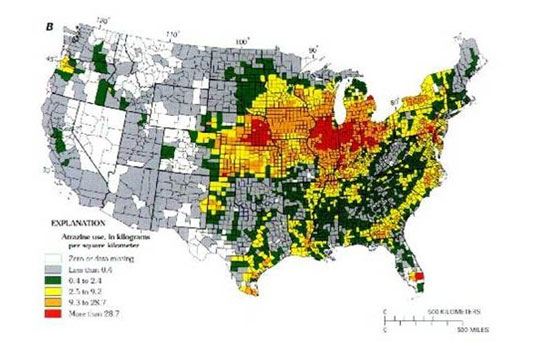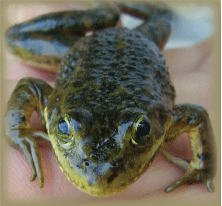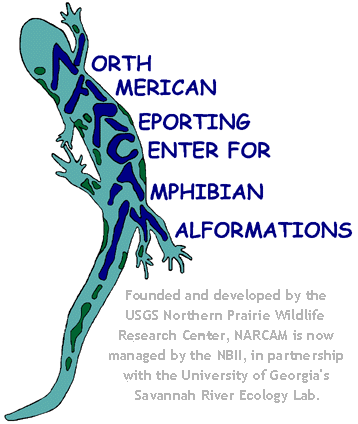- Home
- About S&T
- Taxa/Organisms
- Ecosystems
- Issues
- Methods & Tools
- Reports & Publications
- Location
- Search
Publisher: USGS | Science Center: Patuxent Wildlife Research Center (PWRC, Laurel) | Format: URL
igsaceeswb00.er.usgs.gov:8080 — From the Web site: "The Amphibian Research and Monitoring Initiative (ARMI) National Atlas for Amphibian Distributions (or simply, the ARMI Atlas), is a compilation of current and historic records of amphibian occurrences. These records are from published, peer-reviewed scientific literature, museum records, state and regional herpetological More...

Publisher: USGS | Format: URL
armi.usgs.gov — The U.S. Geological Survey's Amphibian Research and Monitoring Initiative (ARMI) is a multidisciplinary effort to determine the status and trends of amphibians in the U.S., research the causes for amphibian declines, and provide scientific information to decision-makers to help halt or reverse declines. This website includes information on ARMI's More...

Publisher: USGS | Science Center: Northern Prairie Wildlife Research Center (NPWRC, Jamestown) | Format: URL
www.npwrc.usgs.gov — Interest in amphibians continues to rise as people become more aware of this fascinating group of animals. To the uninitiated all frogs may look alike; ditto for salamanders (in the same manner that beginning birders are overwhelmed by the immense variety of small brown birds). One of the purposes of this checklist and online identification guide More...

February 2004 | Publisher: USGS (Amphibian Research and Monitoring Initiative (ARMI)) | Science Center: USGS Other | Format: URL
armi.usgs.gov — At least 13 amphibian species are found on the Colorado Plateau, although some have very limited distributions in this bioregion. Amphibian declines have been documented in many parts of the world, but knowledge of amphibians on the Colorado Plateau is inadequate to determine population status or trends for most species. The U.S. Geological More...

Publisher: USGS | Science Center: National Wetlands Research Center (NWRC, Lafayette) | Format: URL
www.nwrc.usgs.gov — The south-central region includes the States of Texas, Oklahoma, Arkansas, Mississippi, and Louisiana. We are currently conducting research projects designed to monitor amphibians on Federal lands in these States and to research possible causes of declines in amphibian populations. These potential threats include loss or degradation of habitat, More...

Publisher: USGS (South Florida Information Access (SOFIA)) | Science Center: USGS Other | Format: URL
sofia.usgs.gov — This project uses data on detection of amphibian species after repeated sampling at a site to estimate the occupancy rate of various amphibian species (MacKenzie et al., 2002). Declines in amphibian populations have been documented for many regions and habitat types worldwide (Alford and Richards, 1999). No single cause for declines has been More...

Publisher: USGS | Science Center: Columbia Environmental Research Center (CERC, Columbia) | Format: URL
www.cerc.usgs.gov — The primary goal of the proposed research is to evaluate selenium and atrazine exposure and effects to fish, amphibians, and waterfowl that utilize the Refuge. The following subordinate objectives will be met to investigate selenium exposure and effects to wildlife on the Refuge: 1.Measure selenium concentrations and total organic content in More...

Publisher: USGS | Science Center: Forest and Rangeland Ecosystem Science Center (FRESC, Corvallis) | Format: URL
fresc.usgs.gov — The Conservation Genetics Lab carries out molecular analysis, pedigree analysis, modeling, data management, and cryogenic sample repository. As a part of this research, the lab investigates the effectiveness of molecular markers used to enhance enforcement of the Endangered Species Act policy. During the past 15 years, this research has involved More...

Publisher: USGS | Science Center: Forest and Rangeland Ecosystem Science Center (FRESC, Corvallis) | Format: URL
fresc.usgs.gov — ARMI is an initiative of agencies within the United States Department of the Interior to measure, understand, and respond to effects of environmental change upon the Nation's amphibians. Amphibians have been disappearing from many locations around the world and reports of declines have increased in recent decades. Some of the most dramatic More...

Publisher: USGS | Science Center: Fort Collins Science Center (FORT, Ft. Collins) | Format: URL
www.fort.usgs.gov — The Department of the Interior's Amphibian Research and Monitoring Initiative (ARMI) is designed to determine where populations of amphibians are present, to monitor specific apex populations, and to investigate potential causes of decline and deformity. The Rocky Mountain Region of ARMI encompasses Montana, Wyoming, Colorado, and New Mexico. Two More...

Publisher: USGS | Science Center: Florida Integrated Science Center (FISC, Gainesville) | Format: URL
fl.biology.usgs.gov — The objectives of Southeastern ARMI are to determine the status and trends of amphibian populations on DOI lands in the southeastern United States and U.S. Caribbean and to provide information useful in determining causes of declines should they be discovered. Meeting the needs and expectations of the Nation for monitoring the status of More...

Publisher: NBII | Format: URL
www.nbii.gov — NARCAM is a website reporting system for malformed amphibian malformations. The site is a portal of archives for malformed amphibian phenomena reports in the United States and Canada. Users can submit a Report to NARCAM, view malformations data, with access to maps of malformation occurrences. You can also learn more about the UV radiation, More...
